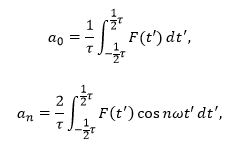Nearly any periodic function can be represented as a
linear combination of simple, sinusoidal waves.
By applying a process known as a Fourier transform, one can represent a
complicated periodic function as an approximation displaying each individual component
in superposition.
The Fourier transformation process consists of rewriting
the original F(t) function in the
form of
where n is an
integer from 1 to infinity, ω represents angular frequency, t is time, and a0, an,
and bn are
coefficients. To determine the a0, an, and bn
coefficients, it is necessary to evaluate three integrals:
and
After determining each coefficient, the
process is completed by plugging each in to its respective place within the
Fourier series form of F(t).
Example:
(Problem 3-28 from Classical Dynamics of
Particles and Systems 5th Edition by Thornton and Marion)
Obtain the Fourier expansion for the
function
in the interval –π/ω
< t < π/ω where ω = 1 rad/s.
Solution:
After plotting the function, we determine
that the function is odd as F(-t) = -F(t),
or the values on the left and right side of the y-axis are of equal absolute
value but opposite in sign. This means
that a0 must equal 0 as
the integral of an odd function of period 2π over the interval –π/ω < t <
π/ω is always 0.
So,
Similarly, when determining an, we have an odd function F(t) times an even function cos(nωt). This results in an overall odd function F(t)cos(nωt). Thus, for the same reasons as a0,
When determining bn, we have an odd function F(t) times an odd function sin(nωt)
resulting in an overall even function F(t)sin(nωt). In this case, we must take the integral.
Thus,
or
By plotting the original function and the
Fourier expansion including various numbers of terms, it is clear that as the
number of terms included in the expansion increases, the Fourier series plot
approaches that of the original function.
Below are plots of the original function, the Fourier series including
two terms, the Fourier series including three terms, and the Fourier series
including four terms, respectively.












No comments:
Post a Comment